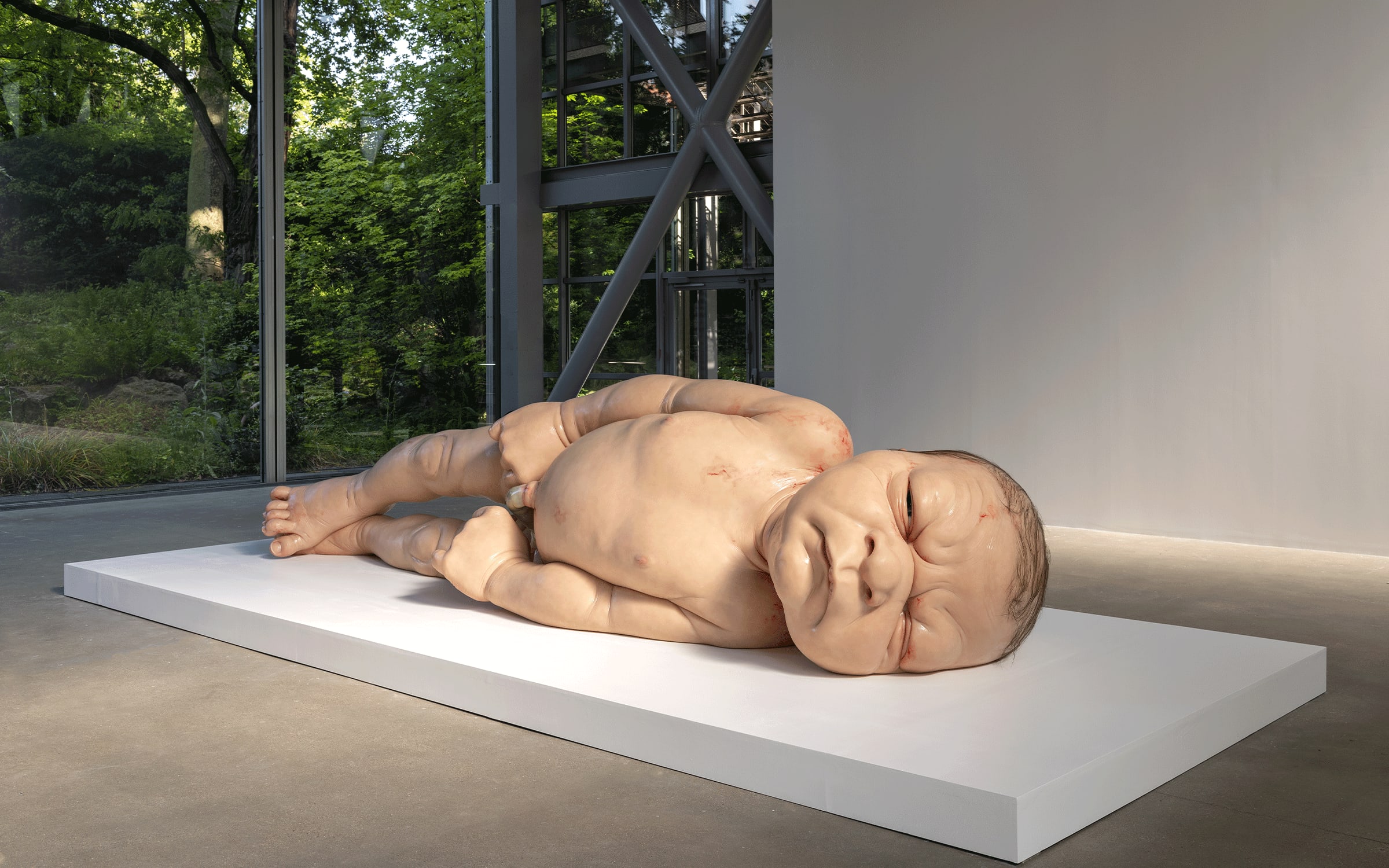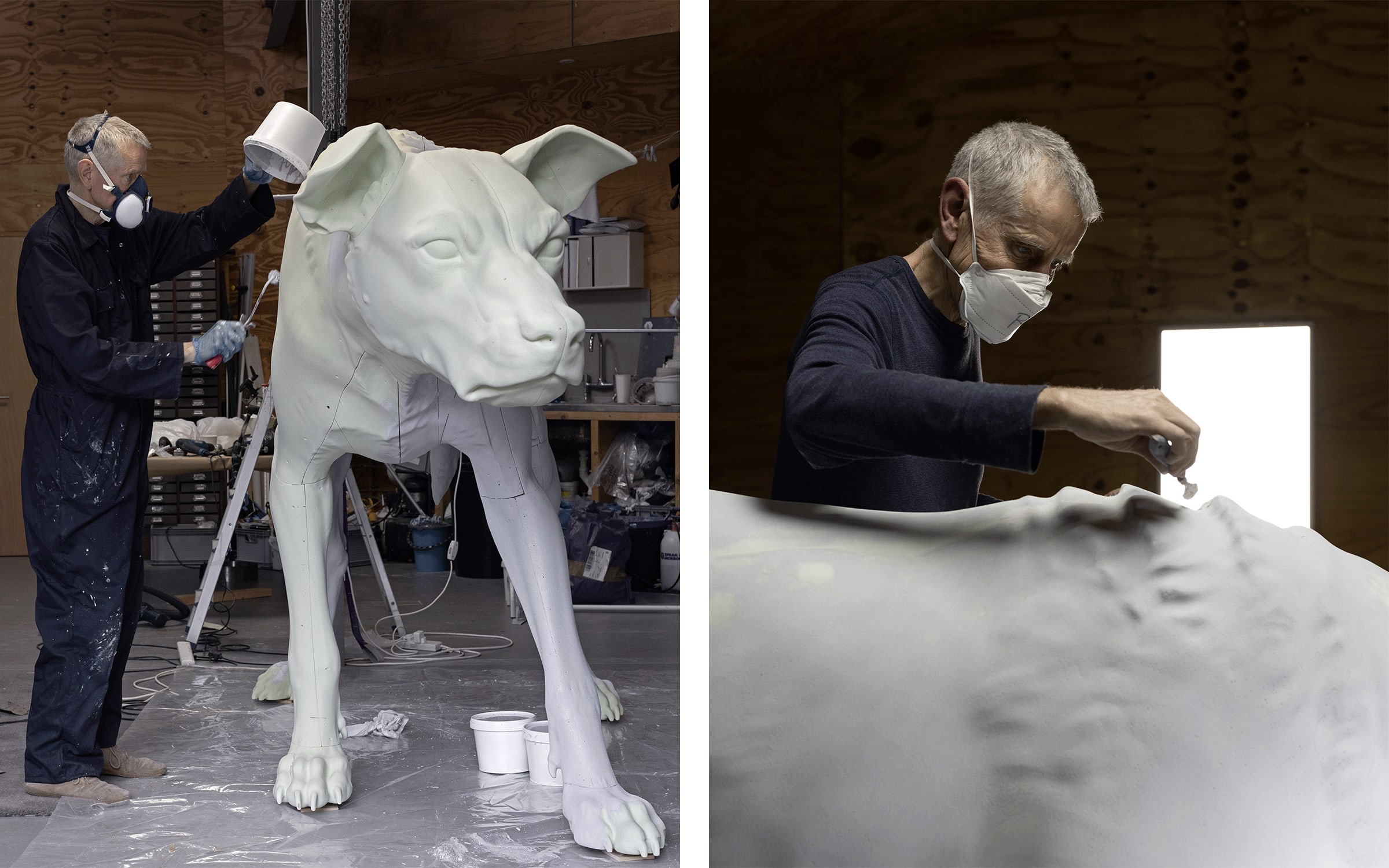In collaboration with Numéro art
In today’s art world, the word ‘excess’ is overused. However, as far as Ron Mueck’s work is concerned, the term reclaims its original meaning. Proof can be found at Fondation Cartier, where the Australian sculptor has unveiled a monumental installation as part of his new exhibition on until fall. A hundred white resin skulls, each up to 1.5 meters high, are piled up in the Jean Nouvel-designed building. Surrounded by this mound of heads, the visitors have no choice but to immerse themselves in this ultra-modern, gigantic vanitas. Mueck’s Mass (2017) is a spectacular feat that reveals to a European audience a new development in his sculptural practice.
In the large room on the ground floor of Fondation Cartier, a giant newborn baby – A Girl (2006) – is stretched out on a white plinth, commanding our attention with her immense size and realistic detailing. Wrinkled skin, traces of blood, damp hair, the umbilical cord: Mueck does not shy away from the details. Since the late 1990s, the artist has been working on recreating the flesh of living beings with surgical precision, usually going from a clay mold to a figure made of resin or silicone that he then paints, adding hair and clothes. Mueck’s remarkable technique has established him as a leading figure of hyperrealist sculpture – a label he himself rejects, as for him, everything is about proportion.

Either barely taller than a vase or twice the size of the average man, his spectacular artworks skillfully depart from nature and trigger a powerful and troubling sense of unease in the visitor. The work described above is a perfect example: it looks repulsive, monstrous even, yet in fact it is very faithful to its model. This ambivalence sets him apart from figures who could be seen as is predecessors, such as Duane Hanson and John DeAndrea: Mueck does not seek to transcribe reality, but rather to use its components to better unsettle the audience.
Mueck pays the same attention to detail in all of his works, whatever their size. Given the scale of his sculptures, one might picture him surrounded by dozens of assistants, but in fact, the opposite is true. A number of years ago, the artist set up his studio on the Isle of Wight, off the south coast of England, where he creates everything all by himself. ‘Everything has to come from him, even the most insignificant gesture,’ Charlie Clarke explains. The latter, a close friend and collaborator of the artist for over twenty years, and the associate curator of this new exhibition, manages the logistics required for the works, from their conservation to their installation. ‘I’m like an extra pair of hands, an extension of him. I assist and advise him, but I never replace him,’ Clarke explains – also acting as his spokesman, since Mueck himself refuses to speak publicly about his work. ‘Ron has always favored craft over discourse,’ Clarke states. ‘For him, a work should stand on its own.’
Fondation Cartier first presented Mueck’s work to the French public in 2005. Since then, the Parisian institution and its director Hervé Chandès have been among its most fervent supporters, as reflected by this third solo exhibition. Throughout the 2000s, his work was exhibited worldwide, from the 49th Venice Biennale in 2001 to a solo show the Andy Warhol Museum in Pittsburgh, PA in 2007. The artist was represented by Hauser & Wirth for almost ten years, before joining Thaddaeus Ropac in 2020. Despite his international reputation, Mueck’s creative process remains very slow. For the hundred giant skulls of Mass (2017), it took the artist an entire year to design the original mold, and another year to make 99 copies from it.

Although Mueck conceives his work as a continuum with no breaking point, this new exhibition reveals some sculptural innovations. With the dazzling white monochrome skulls and the three gigantic black dogs in the basement, the artist has gradually emancipated himself from realism and focused on the effect caused by an increasingly absolute work. Like Cerberus, Mueck’s three-meter-high trio of dogs stand in the dimly lit space, confronting visitors with their immensity and menacing presence. Though faithful to his hand-crafted technique, Mueck also relies on new technologies, such as 3D printing, which helped him design this particular work. Yet, the most surprising piece in the exhibition is a small sculpture made of red clay – a scene in which five men tie up a pig on the ground. For the first time in his career, the Australian artist chose to leave the clay raw, just marked by a few fingerprints, as a deliberate form of imperfection. ‘Ron was working on this new series of sculptures and wanted to include them in the catalogue,’ Clarke says. ‘So he chose to present this one, even though it was still a work in progress, as if he was making a freeze-frame.’
At odds with the thematic display, this is exactly what this new exhibition offers – the assessment of monumental and ‘timeless’ work, which fosters an endless reflection on the human condition that extends far beyond our lives. Through a fortunate turn of events, the very last work in the exhibition was installed right at the end of our visit. A version of Mass, but this time with the white skulls cast in bronze. Weighing over one ton, the black vanitas declares loud and clear the famous aphorism memento mori; offering proof that excess can also be humbling in the face of our inevitable finiteness.
This article is part of a yearlong collaboration between Paris+ par Art Basel and Numéro art. Click here to read the original article.
Ron Mueck is represented by Thaddaeus Ropac (London, Paris, Salzburg, Seoul).
Matthieu Jacquet is a journalist and art critic based in Paris. He writes about art and fashion for Numéro and Numéro art.
English translation: Emma Naroumbo Armaing for Numéro art.
Published on July 25, 2023.
Caption for full-bleed images, from top to bottom: 1, 2. Ron Mueck, Mass, 2017. Installation view of Ron Mueck’s exhibition at Fondation Cartier pour l’art contemporain, Paris, 2023. National Gallery of Victoria, Melbourne, Felton Bequest, 2018. © Marc Domage. 3. Ron Mueck, En Garde, 2023. Installation view of Ron Mueck’s exhibition at Fondation Cartier pour l’art contemporain, Paris, 2023. Courtesy of Thaddaeus Ropac © Marc Domage.